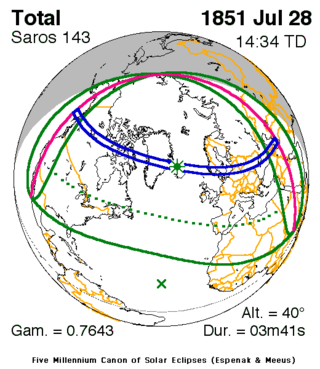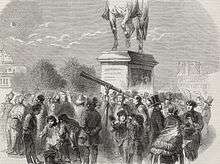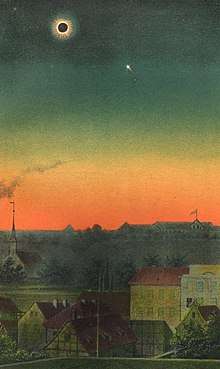Solar eclipse of July 28, 1851
The earliest scientifically useful photograph of a total solar eclipse was made by Julius Berkowski at the Royal Observatory in Königsberg, Prussia, on Monday, July 28, 1851. It was the first correctly exposed photographic image taken during totality thereby including the Sun's corona.
| Solar eclipse of July 28, 1851 | |
|---|---|
 Berkowski made this first solar eclipse photograph at the Royal Observatory in Königsberg, Prussia (now Kaliningrad, Russia) | |
 Map | |
| Type of eclipse | |
| Nature | Total |
| Gamma | 0.7644 |
| Magnitude | 1.0577 |
| Maximum eclipse | |
| Duration | 221 sec (3 m 41 s) |
| Coordinates | 68°N 19.6°W |
| Max. width of band | 296 km (184 mi) |
| Times (UTC) | |
| Greatest eclipse | 14:33:42 |
| References | |
| Saros | 143 (14 of 72) |
| Catalog # (SE5000) | 9167 |
Background
A solar eclipse occurs when the Moon passes between the Earth and the Sun, casting a shadow on Earth that temporarily obscures part or all of the Sun's disc. Eclipses can occur only when all three bodies are properly aligned. Partial eclipses, in which only a portion of the Sun's surface is obscured, are relatively common due to the width of the Moon's outer shadow, or penumbra, which may be several hundred miles wide. Total eclipses occur when the Moon's inner shadow, or umbra, reaches the surface of the Earth, completely obscuring the Sun over a much narrower portion of the ground. If the Moon is too far away at the time of an eclipse, its umbra may not reach the Earth's surface, and only a partial eclipse will be visible.
Before the advent of modern science, solar eclipses were often viewed with superstitious dread. However, eclipses are also of interest to science due to the various phenomena that can be observed when they occur. The corona is normally invisible due to the brightness of the solar disc, but becomes visible from Earth during a total eclipse. Until the twentieth century, solar eclipses provided the only opportunity for scientists to observe and study the Sun's corona. With the development of photography during the first half of the nineteenth century, it became theoretically possible to record a still image of the Sun during a total eclipse. A variety of processes were used for early photographs, of which the most successful was the Daguerreotype.
Monday, July 28, 1851

Photographing a rare event such as a total eclipse posed unique challenges for early photography, including the extreme contrast between the corona and the dark shadow of the Moon, as well as the unusual angle to which photographic equipment had to be oriented. Prior to the eclipse of July 28, 1851, no properly exposed photograph of the solar corona had yet been produced. For this occasion, the Royal Prussian Observatory at Königsberg (now Kaliningrad, Russia) commissioned one of the city's most skilled daguerreotypists, Johann Julius Friedrich Berkowski, to record a still image of the event.[1] The observers attached a small six-centimeter refracting telescope to a 15.8 centimeter Fraunhofer heliometer, and Berkowski made an eighty-four second exposure shortly after the beginning of totality.[2]
Among the other observers were British astronomers Robert Grant and William Swan, and Austrian astronomer Karl Ludwig von Littrow. They deduced that prominences were part of the Sun, because the Moon was seen to cover and uncover them as it moved in front of the Sun.[3]

Related eclipses
The eclipse of July 28, 1851 was part of Saros Series 143, a sequence of seventy-two partial and total solar eclipses occurring between 1617 and 2897. The only total eclipses in this cycle occurred between 1797 and 1995.[4]
References
- Axel D. Wittmann and Reinhard E. Schielicke, "Richard und John Parish, Förderer der Astronomie zur Zeit von Gauß, und die Sonnenfinsternis–Daguerreotypie von Julius Berkowski (1851)", University of Jena, Astrophysical Institute and University Observatory (2013).
- Schielicke, Reinhard; Wittmann, Axel D. (2005). "On the Berkowski daguerreotype (Königsberg, 1851 July 28): the first correctly-exposed photograph of the solar corona". Acta Historica Astronomiae. 25: 128. Bibcode:2005AcHA...25..128S.CS1 maint: uses authors parameter (link)
- http://www.mreclipse.com/Totality2/TotalityApH.html
- National Aeronautics and Space Administration, "Saros Series 143", in Saros Series Catalog of Solar Eclipses NASA Eclipse Web Site, retrieved 10 November 2016.
External links
| Wikimedia Commons has media related to Solar eclipse of 1851 July 28. |
- NASA chart graphics
- Axel D. Wittmann (2005). Development of Solar Research: Proceedings of the Colloquium, Freiburg (Breisgau), September 15, 2003. Deutsch. p. 128. ISBN 978-3-8171-1755-0.
- FIRST SUN PHOTO
- On the Berkowski Daguerreotype (Konigsberg, 1851 July 28): The First Correctly Exposed Eclipse Photograph of the Solar Corona
- From eclipse drawings to the coronagraph and spectroscopy
- History of Astrophotography Timeline
- Sketch of Solar Corona 1851 July 28
- Solar eclipse of July 28, 1851 in Russia
.jpg)
